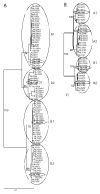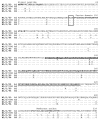Antigenic and genetic variability of human metapneumoviruses
- PMID: 15200856
- PMCID: PMC3323073
- DOI: 10.3201/eid1004.030393
Antigenic and genetic variability of human metapneumoviruses
Abstract
Human metapneumovirus (HMPV) is a member of the subfamily Pneumovirinae within the family Paramyxo- viridae. Other members of this subfamily, respiratory syncytial virus and avian pneumovirus, can be divided into subgroups on the basis of genetic or antigenic differences or both. For HMPV, the existence of different genetic lineages has been described on the basis of variation in a limited set of available sequences. We address the antigenic relationship between genetic lineages in virus neutralization assays. In addition, we analyzed the genetic diversity of HMPV by phylogenetic analysis of sequences obtained for part of the fusion protein (n = 84) and the complete attachment protein open reading frames (n = 35). On the basis of sequence diversity between attachment protein genes and the differences in virus neutralization titers, two HMPV serotypes were defined. Each serotype could be divided into two genetic lineages, but these did not reflect major antigenic differences.
Figures



Similar articles
-
The two major human metapneumovirus genetic lineages are highly related antigenically, and the fusion (F) protein is a major contributor to this antigenic relatedness.J Virol. 2004 Jul;78(13):6927-37. doi: 10.1128/JVI.78.13.6927-6937.2004. J Virol. 2004. PMID: 15194769 Free PMC article.
-
Genetic variability of the G glycoprotein gene of human metapneumovirus.J Clin Microbiol. 2004 Aug;42(8):3532-7. doi: 10.1128/JCM.42.8.3532-3537.2004. J Clin Microbiol. 2004. PMID: 15297494 Free PMC article.
-
Genetic diversity and molecular evolution of the major human metapneumovirus surface glycoproteins over a decade.J Clin Virol. 2013 Nov;58(3):541-7. doi: 10.1016/j.jcv.2013.08.029. Epub 2013 Sep 4. J Clin Virol. 2013. PMID: 24041471
-
[Human metapneumovirus as a common cause of respiratory tract disease].Vopr Virusol. 2007 May-Jun;52(3):4-8. Vopr Virusol. 2007. PMID: 17601042 Review. Russian.
-
Live vaccines for human metapneumovirus designed by reverse genetics.Expert Rev Vaccines. 2006 Oct;5(5):695-706. doi: 10.1586/14760584.5.5.695. Expert Rev Vaccines. 2006. PMID: 17181442 Review.
Cited by
-
Human metapneumovirus associated with community-acquired pneumonia in children in Beijing, China.J Med Virol. 2013 Jan;85(1):138-43. doi: 10.1002/jmv.23438. Epub 2012 Oct 23. J Med Virol. 2013. PMID: 23097275 Free PMC article.
-
Antibody recognition of the Pneumovirus fusion protein trimer interface.PLoS Pathog. 2020 Oct 9;16(10):e1008942. doi: 10.1371/journal.ppat.1008942. eCollection 2020 Oct. PLoS Pathog. 2020. PMID: 33035266 Free PMC article.
-
European and American subgroup C isolates of avian metapneumovirus belong to different genetic lineages.Virus Genes. 2006 Feb;32(1):97-103. doi: 10.1007/s11262-005-5850-3. Virus Genes. 2006. PMID: 16525740
-
Recovery of human metapneumovirus genetic lineages a and B from cloned cDNA.J Virol. 2004 Aug;78(15):8264-70. doi: 10.1128/JVI.78.15.8264-8270.2004. J Virol. 2004. PMID: 15254198 Free PMC article.
-
Development and validation of an enzyme-linked immunosorbent assay for human metapneumovirus serology based on a recombinant viral protein.Clin Diagn Lab Immunol. 2005 Feb;12(2):249-53. doi: 10.1128/CDLI.12.2.249-253.2005. Clin Diagn Lab Immunol. 2005. PMID: 15699418 Free PMC article.
References
-
- Collins PL, McIntosh K, Chanock RM. 1. Respiratory syncytial virus. In: H.P.M. Knipe, editor. Fields virology. Philadelphia: Lippencott Williams and Wilkins; 2001. p. 1443–85.
Publication types
MeSH terms
Substances
LinkOut - more resources
Full Text Sources
Other Literature Sources
